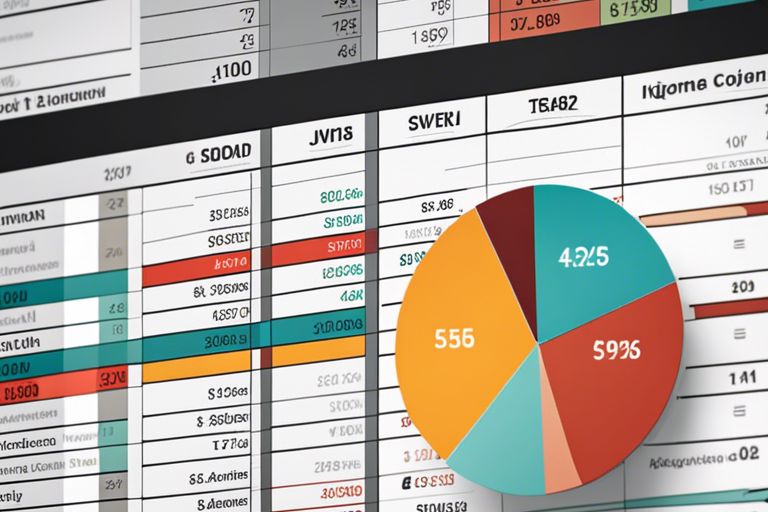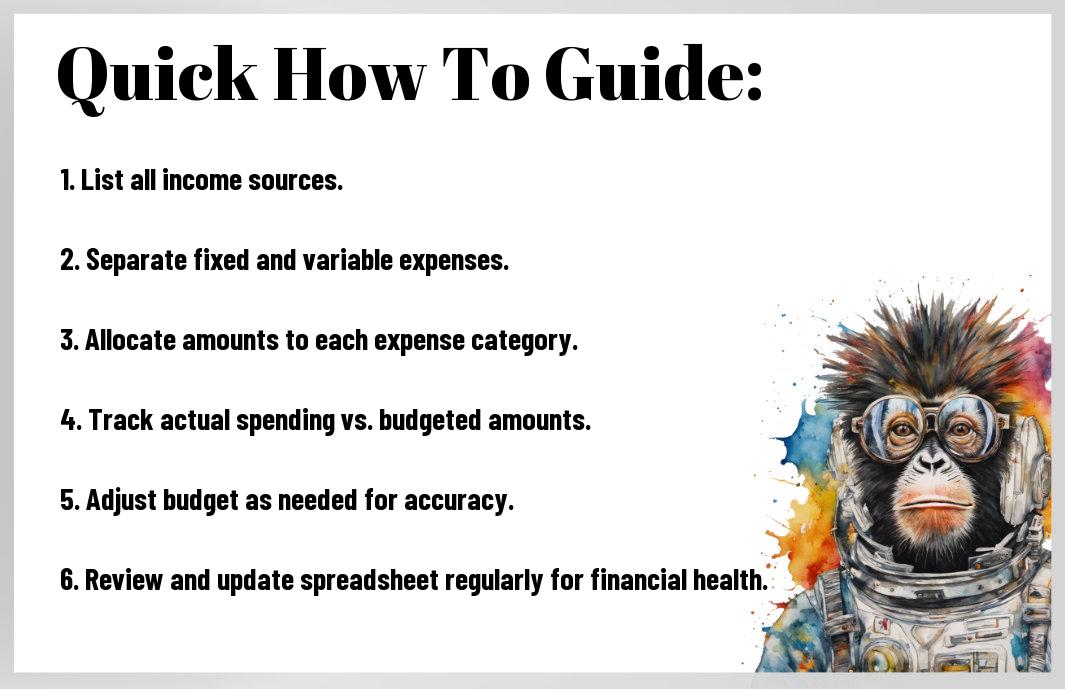How To Create A Budgeting Spreadsheet That Works For You?
This step-by-step guide will show you how to create a personalized budgeting spreadsheet that fits your financial goals and lifestyle. By following these instructions, you can take control of your finances and track your expenses effectively. Budgeting is crucial for financial stability, and having a customized spreadsheet can make the process easier and more manageable. Let’s dive in and start building a budgeting tool that works for you!

Key Takeaways:
- Customize your budgeting spreadsheet: Tailor your spreadsheet to fit your personal financial goals and needs. Include categories that are relevant to your expenses and income.
- Track your expenses consistently: Regularly input your expenses and income to keep a clear picture of your financial situation. This will help you stay on budget and make necessary adjustments.
- Set realistic financial goals: Establish achievable short-term and long-term financial goals to guide your budgeting process. Having clear goals will motivate you to stick to your budget.
- Use formulas and functions: Automate calculations in your spreadsheet by utilizing formulas and functions. This will help you easily track totals, percentages, and other important financial metrics.
- Review and update your budget regularly: Take time to review your budgeting spreadsheet regularly to identify any trends or areas for improvement. Adjust your budget as needed to ensure it continues to work for you.

Getting Started with Your Budgeting Spreadsheet
Factors to Consider Before Creating Your Spreadsheet
While launching on creating your budgeting spreadsheet, it’s imperative to consider a few key factors to ensure its effectiveness. Factors to keep in mind include your financial goals, income sources, expenses, and any existing debts.
- Identify your financial goals
- List all sources of income
- Track your regular expenses
- Consider any outstanding debts
Any successful budgeting spreadsheet is rooted in a clear understanding of your financial situation.
Equipment and Tools You Will Need
You will need a computer with spreadsheet software such as Microsoft Excel or Google Sheets to create your budgeting spreadsheet. Ensure you have a stable internet connection and basic proficiency in using spreadsheet software.
The key to utilizing these tools effectively lies in understanding the functions and formulas that can simplify your budgeting process.
Designing Your Budgeting Spreadsheet
How to Structure Your Spreadsheet
You must consider how to structure your budgeting spreadsheet to ensure it meets your needs. Include separate columns for income, fixed expenses, variable expenses, savings, and any other categories that fit your financial situation. Consider grouping expenses by category and tracking them over time to identify trends.
Tips for Effective Categorization of Expenses
When categorizing your expenses, keep it simple and specific. Avoid creating too many categories that can make tracking difficult. Consider grouping similar expenses together to get a clear picture of where your money is going. This will help you analyze your spending habits and make informed decisions about where to cut back or reallocate funds.
- Use broad categories like housing, transportation, utilities, groceries, entertainment, and savings to capture most of your expenses.
- Avoid creating categories for every single expense; instead, group similar items together to streamline the process.
- This will make it easier to track your spending and make adjustments as needed.
Implementing Your Budget Plan
Managing Your Income and Expenses
On the journey to financial stability, managing your income and expenses is crucial. It is imperative to track your earnings and expenditures accurately to understand where your money is going. By using tools like spreadsheets or budgeting apps, you can easily monitor your cash flow and make informed decisions about your financial future. For a step-by-step guide on how to create a budget spreadsheet in Google Sheets and Microsoft Excel, check out this How To Make A Budget In Google Sheets And Microsoft Excel.
Adjusting Your Budget as You Go
Implementing a budget plan is not a one-time task; it requires regular monitoring and adjustments. As you progress in your financial journey, your income and expenses may fluctuate. It is imperative to review your budget regularly and make necessary changes to ensure that it aligns with your current financial situation and goals. By keeping a close eye on your budget and being flexible with adjustments, you can stay on track towards achieving your financial objectives.
Advanced Budgeting Techniques
Many people struggle with creating a budget that truly works for them. To take your budgeting spreadsheet to the next level, consider implementing some advanced budgeting techniques. Below are some strategies to consider:
- How to Forecast Future Spending
- Identifying and Cutting Unnecessary Expenses
How to Forecast Future Spending
Clearly forecasting your future spending is important for effective budgeting. By analyzing your past expenses and considering upcoming financial goals and commitments, you can better anticipate where your money will go in the future. This information will help you allocate resources wisely and avoid financial surprises.
Identifying and Cutting Unnecessary Expenses
Little changes can add up to significant savings over time. By identifying and cutting unnecessary expenses from your budget, you can free up more money for savings, investments, or other financial goals. Take a close look at your spending habits and prioritize what truly adds value to your life.
To effectively identify and cut unnecessary expenses, start by reviewing your recent bank statements and receipts. Look for any recurring charges or impulse purchases that you could do without. Consider alternatives or cheaper options for your regular expenses, and be mindful of your spending habits moving forward.
To wrap up
Drawing together all the elements of creating a budgeting spreadsheet that works for you, remember to customize it to fit your unique financial situation. By following the steps outlined in this guide, you can take control of your finances and achieve your financial goals. A budgeting spreadsheet is a powerful tool that can help you track your income, expenses, and savings with precision. Stay disciplined, regularly update your spreadsheet, and make adjustments as needed to stay on track. With consistency and determination, you can use this budgeting tool to make informed financial decisions and secure your financial future.
FAQ
Q: Why is creating a budgeting spreadsheet important?
A: Creating a budgeting spreadsheet is crucial for tracking your income and expenses, helping you stay organized and on top of your finances. It allows you to see where your money is going and make informed decisions to reach your financial goals.
Q: What are the key components of a budgeting spreadsheet?
A: The key components of a budgeting spreadsheet include income sources, expenses, savings goals, tracking categories, and a summary section to provide an overview of your financial situation.
Q: How do I create a budgeting spreadsheet that works for me?
A: To create a budgeting spreadsheet that works for you, start by listing all your income sources and expenses, categorize them, set realistic savings goals, track your spending regularly, and make adjustments as needed to stay on track.
Q: What are some tips for maintaining an effective budgeting spreadsheet?
A: Some tips for maintaining an effective budgeting spreadsheet include updating it regularly, being honest about your spending habits, reviewing your budget monthly, setting aside time for financial check-ins, and seeking support or guidance when needed.
Q: How can a budgeting spreadsheet help me achieve my financial goals?
A: A budgeting spreadsheet can help you achieve your financial goals by providing a clear overview of your finances, guiding your spending decisions, identifying areas where you can cut back, and tracking your progress towards reaching your savings targets.